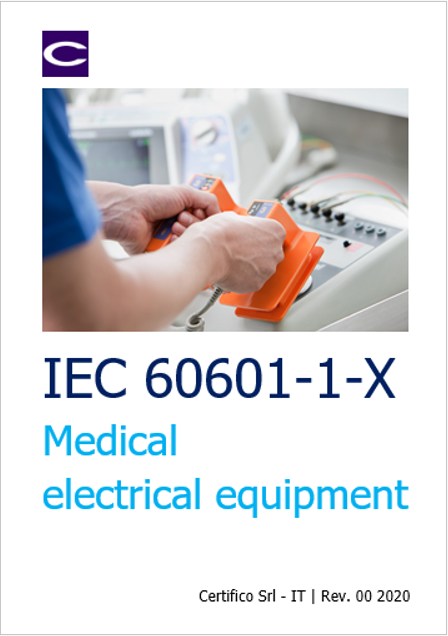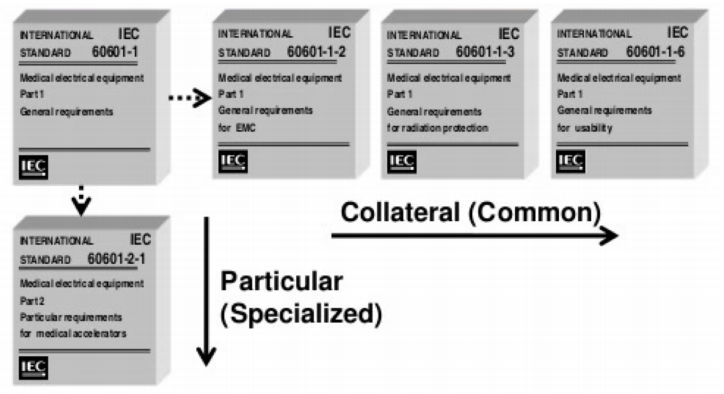IEC 60601-1-X Medical electrical equipment | State 08.2020
| Appunti Marcatura CE | ||
| 15 Maggio 2025 | ||
| Salve Visitatore | ||
IEC 60601-1-X Medical electrical equipment | State 08.2020 ID 11296 | State 08.2020 Stato e Preview allegati delle norme tecniche generali della Serie IEC 620601-1-X per gli apparecchi elettromedicali. IEC 60601 è una serie di norme tecniche per la sicurezza e le prestazioni essenziali degli apparecchi elettromedicali, pubblicate dalla Commissione elettrotecnica internazionale. IEC 60601-X-XX Example The IEC 60601-1-xx series of collateral standards for MEDICAL DEVICE ELECTRICAL EQUIPEMENT La norma generale IEC 60601-1 - Apparecchi elettromedicali - Parte 1: Requisiti generali per la sicurezza di base e le prestazioni essenziali - stabilisce i requisiti generali della serie di norme. IEC 60601-1 è un punto di riferimento ampiamente accettato per le apparecchiature elettromedicali e la conformità a IEC 60601-1 è diventata un requisito per la commercializzazione di apparecchiature elettromedicali in molti paesi (in UE la norma è armonizzata per la Direttiva Dispositivi medici 93/42/CEE e il Regolamento Dispositivi medici (UE) 2017/745 che prevedono la marcatura CE). (1) Premarket approval (PMA) is the FDA process of scientific and regulatory review to evaluate the safety and effectiveness of Class III medical devices, and the most stringent of the device marketing applications. Class III devices are those that support or sustain human life, are of substantial importance in preventing impairment of human health, or which present a potential, unreasonable risk of illness or injury. Due to the level of risk associated with Class III devices, FDA has determined that general and special controls alone are insufficient to assure the safety and effectiveness of Class III devices. Therefore, these devices require a premarket approval (PMA) application under section 515 of the FD&C Act in order to obtain marketing clearance. Please note that some Class III preamendment devices may require a Class III 510(k). PMA applications will include technical sections, usually divided into non-clinical laboratory studies and clinical investigations. PMA approval typically requires a facility inspection to confirm compliance to 21 CFR 820 prior to approval. (2) A 510(k) is the technical dossier required by the US Food and Drug Administration (FDA) to sell a medium-risk medical device or IVD in the United States. It is formally called a Pre-market Notification. A 510(k) contains detailed technical, safety, and performance information about a medical device. The documentation must demonstrate the device in question is "substantially equivalent" to a predicate device (i.e. a product already cleared for sale in the US). The FDA must review the 510(k) and "clear" your device before you can legally sell or distribute it in the United States. 510(k) submissions are required for most Class II (as well as some Class I and Class III) medical devices and IVDs. If you cannot determine the classification for your product, you can submit a 513(g), which is a written request to the FDA seeking classification confirmation. Each person who wants to market in the U.S., a Class I, II, and III device intended for human use, for which a Premarket Approval (PMA) is not required, must submit a 510(k) submission to FDA unless the device is exempt from 510(k) requirements of the Federal Food, Drug, and Cosmetic Act (the Act) and does not exceed the limitations of exemptions in part .9 of the device classification regulation chapters (e.g., 21 CFR 862.9, 21 CFR 864.9). A 510(k) is a premarket submission made to FDA to demonstrate that the device to be marketed is at least as safe and effective (substantially equivalent) to a legally marketed device that is not subject to PMA. Submitters must compare their device to one or more similar legally marketed devices (predicates) and make and support their substantial equivalency claims. Until the submitter receives an order declaring a device SE, the submitter may not proceed to market the device. Once the device is determined to be SE, it can then be marketed in the U.S. IEC 60601-1:2005+AMD1:2012 (Armonizzzata MD) IEC 60601-1:2005+AMD1:2012 IEC 60601-1:2005+A1:2012 contains requirements concerning basic safety and essential performance that are generally applicable to medical electrical equipment. For certain types of medical electrical equipment, these requirements are either supplemented or modified by the special requirements of a collateral or particular standard. Where particular standards exist, this standard should not be used alone. This consolidated version consists of the third edition (2005) and its amendment 1 (2012). Therefore, there is no need to order the amendment in addition to this publication. This document includes the contents of the corrigenda 1 (2006) and 2 (2007), the contents of the corrigendum to Amendment 1 (2014), as well as the interpretation sheets 1 (2008), 2 (2009) and 3 (2013). IEC 60601-1-2:2014 IEC 60601-1-2:2014 applies to the basic safety and essential performance of Medical Equipment (ME) equipment and ME systems in the presence of electromagnetic disturbances and to electromagnetic disturbances emitted by me equipment and me systems. This collateral standard to IEC 60601-1 specifies general requirements and tests for basic safety and essential performance with regard to electromagnetic disturbances and for electromagnetic emissions of ME equipment and ME systems. They are in addition to the requirements of the general standard IEC 60601-1 and serve as the basis for particular standards. This fourth edition cancels and replaces the third edition of IEC 60601-1-2, and constitutes a technical revision. The most significant changes with respect to the previous edition include the following modifications: IEC 60601-1-3:2008+AMD1:2013 IEC 60601-1-3:2008+A1:2013 applies to X-ray equipment and to subassemblies of such equipment, where radiological images of a human patient are used for diagnosis, planning or guidance of medical procedures. The object of this collateral standard is to establish general requirements for protection against X-radiation in X-ray equipment, in order that the irradiation of the human patient, the operator, staff and members of the public can be kept as low as reasonably achievable, without jeopardizing the benefit of the radiological procedure. Particular standards may specify their appropriate values and/or measures for general requirements specified in this collateral standard. The implementation of the general requirements or the reference to the particular standard instead, shall be justified in the risk management process. This collateral standard considers radiation protection aspects related to X-radiation only. Requirements for the control of the electrical energy used to generate X-radiation, which is also an important aspect of radiation protection, are included in IEC 60601-1 and in particular standards for the safety and essential performance of the equipment concerned. This document cancels and replaces the first edition of IEC 60601-1-3, published in 1994 (which replaced IEC 60407 issued in 1973). It constitutes a technical revision. This edition has been restructured and aligned to IEC 60601-1(2005) and focussed on general requirements for RADIATION PROTECTION that apply to all diagnostic X-RAY EQUIPMENT. Requirements particular to specific equipment have been removed and will be covered in particular standards. For a description of the changes, see the mapping in Annex C. This consolidated version consists of the second edition (2008) and its amendment 1 (2013). Therefore, no need to order amendment in addition to this publication. IEC 60601-1-6:2010+AMD1:2013+AMD2:2020 IEC 60601-1-6:2010+A1:2013+A2:2020 specifies a process for a manufacturer toanalyse, specify, design, verify and validate usability, as it relates to basic safety and essential performance of medical electrical equipment. This usability engineering process assesses and mitigates risks caused by usability problems associated with correct use and use errors, i.e., normal use. It can be used to identify but does not assess or mitigate risks associated with abnormal use. If the usability engineering process detailed in this collateral standard has been complied with and the acceptance criteria documented in the usability validation plan have been met (see 5.9 of IEC 62366:2007), then the residual risks, as defined in ISO 14971, associated with usability of me equipment are presumed to be acceptable, unless there is objective evidence to the contrary (see 4.1.2 of IEC 62366:2007). The object of this collateral standard is to specify general requirements that are in addition to those of the general standard and to serve as the basis for particular standards. This document cancels and replaces the second edition of IEC 60601-1-6 which has been technically revised. It was revised to align with the usability engineering process in IEC 62366. To allow for equipment manufacturers and testing organizations to make products and to equip themselves for conducting revised tests in accordance with this third edition, it is recommended by SC 62A that the content of this document not be adopted for mandatory implementation earlier than 3 years from the date of publication for equipment newly designed and not earlier than 5 years from the date of publication for equipment already in production. This consolidated version consists of the third edition (2010), its amendment 1 (2013) and its amendment 2 (2020). Therefore, no need to order amendments in addition to this publication IEC 60601-1-8:2006+AMD1:2012+AMD2:2020 IEC 60601-1-8:2006+A1:2012+A2:2020 Specifies basic safety and essential performance requirements and tests for alarm systems in medical electrical equipment and medical electrical systems and to provide guidance for their application. This is accomplished by defining alarm categories (priorities) by degree of urgency, consistent alarm signals and consistent control states and their marking for all alarm systems. This consolidated version consists of the second edition (2006), its amendment 1 (2012) and its amendment 2 (2020). Therefore, no need to order amendments in addition to this publication. IEC 60601-1-9:2007+AMD1:2013+AMD2:2020 IEC 60601-1-9:2007+A1:2013+A2:2020 The objective of this collateral standard is to improve the environmental impact for the entire range of medical electrical equipment, taking into account all stages of the product life cycle: IEC 60601-1-10:2007+AMD1:2013+AMD2:2020 IEC 60601-1-10:2007+A1:2013+A2:2020 Specifies requirements for the development (analysis, design, verification and validation) of a physiologic closed-loop controller (PCLC) as part of a physiologic closed-loop control system (PCLCS) in medical electrical equipment and medical electrical systems to control a physiologic variable. This collateral standard applies to various types of PCLC, e.g. linear and non-linear, adaptive, fuzzy, neural networks. This collateral standard applies to a closed-loop controller that sets the controller output variable in order to adjust (i.e., change or maintain) the measured physiologic variable by relating it to the reference variable. This consolidated version consists of the first edition (2007), its amendment 1 (2013) and its amendment 2 (2020). Therefore, no need to order amendments in addition to this publication. IEC 60601-1-11:2015+AMD1:2020 IEC 60601-1-11:2015+A1:2020 applies to the basic safety and essential performance of medical electrical equipment and medical electrical systems for use in the home healthcare environment. It applies regardless of whether the medical electrical equipment or medical electrical system is intended for use by a lay operator or by trained healthcare personnel. The home healthcare environment includes: IEC 60601-1-12:2014+AMD1:2020 IEC 60601-1-12:2014+A1:2020 constitutes a collateral standard to IEC 60601-1: Medical electrical equipment - Part 1: General requirements for basic safety and essential performance hereafter referred to as the general standard. Medical practice is increasingly using medical electrical equipment and medical electrical systems for monitoring, treatment or diagnosis of patients in the emergency medical services environment. The safety of medical electrical equipment in this uncontrolled, rough environment is a cause for concern. This collateral standard was developed with contributions from clinicians, engineers and regulators. The terminology, requirements, general recommendations and guidance of this collateral standard are intended to be useful for manufacturers of medical electrical equipment and medical electrical systems and for technical committees responsible for the development of particular standards. This International Standard applies to the basic safety and essential performance of medical electrical equipment and medical electrical systems, hereafter referred to as ME equipment and ME systems, which are intended, as indicated in the instructions for use by their manufacturer, for use in the EMS environment (Emergency Medical Services environment). The object of this collateral standard is to provide general requirements for ME equipment and ME systems carried to the scene of an emergency and used there, as well as in transport, in situations where the ambient conditions differ from indoor conditions. The object of this collateral standard is to specify general requirements that are in addition to those of the general standard and to serve as the basis for particular standards. This consolidated version consists of the first edition (2014) and its amendment 1 (2020). Therefore, no need to order amendment in addition to this publication. IEC TR 62348:2012 IEC/TR 62348:2012(E) which is a technical report, provides a tool to assist users of IEC 60601-1:2005 to assess the impact of the most significant changes in Amendment 1:2012. This technical report also provides a tool to assist users of IEC 60601-1 to trace requirements between the third edition and their source in the documents that form the basis of the third edition; principally the second edition as amended. This report is intended to be used by: Certifico Srl - IT | Rev. 00.2020 Collegati  |
||
 |
||
| www.certifico.com
è un sito di INVIO NEWSLETTTER Se vuoi cancellarti dall'invio della newsletter oppure effettua il login al sito ed entra nella Tua Area Riservata, in “Modifica dati” agisci con la spunta sul box di selezione “nNewsletter”. L'Elenco completo di tutte le ns newsletter è qui: Archivio newsletter. |
||
  |
||
| Certifico Srl 2000-2020 | VAT IT02442650541 | ||


































